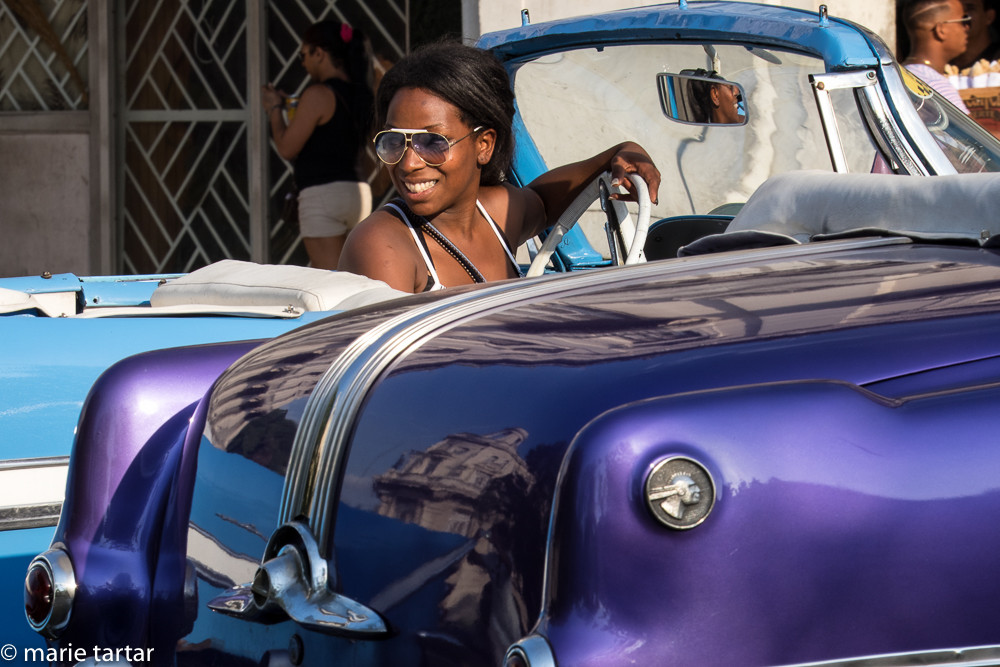
Tuesday, July 14, 2015
Leaving Steve behind in San Diego, not knowing if he would be able to leave in time for our dive trip, or if we would have Internet to even know if he was coming, Greg and I set about making the most of our 3 days to explore La Habana.
Our home for this stay was the terrifically located Iberostar Hotel Parque Central, an oasis situated on the border of Havana Vieja and Havana Central. On one flank, the lovely tree and bench lined Prado promenade leads to the seaside Malecón.
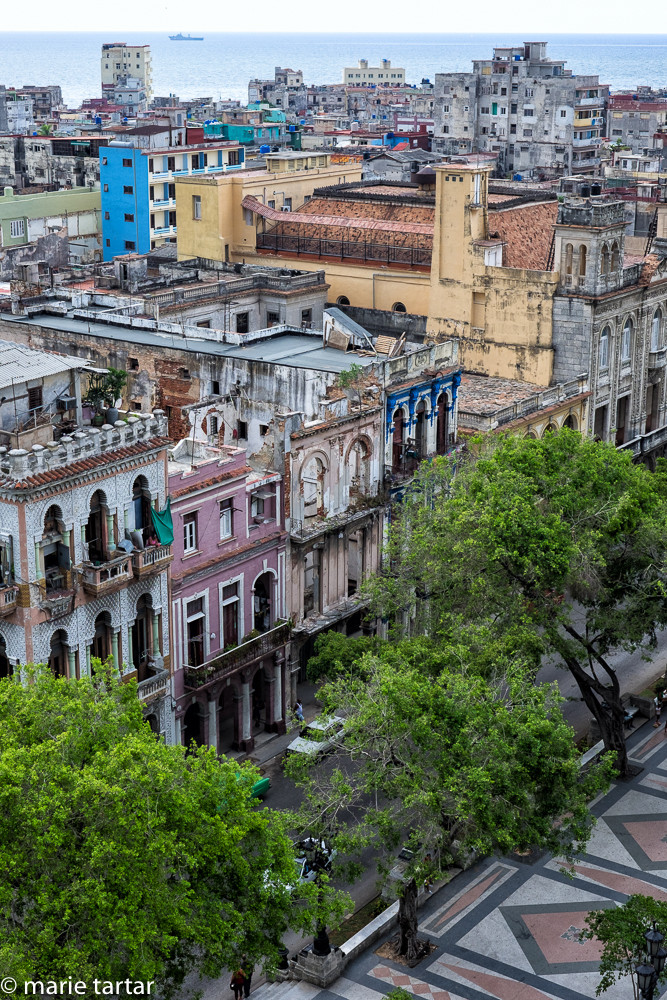
Tree-lined Prado functions as an outdoor living room, with kids skating, men playing chess, lovers canoodling. From the hotel roofdeck, one readily sees both the architectural grandeur and dereliction of Central Havana.
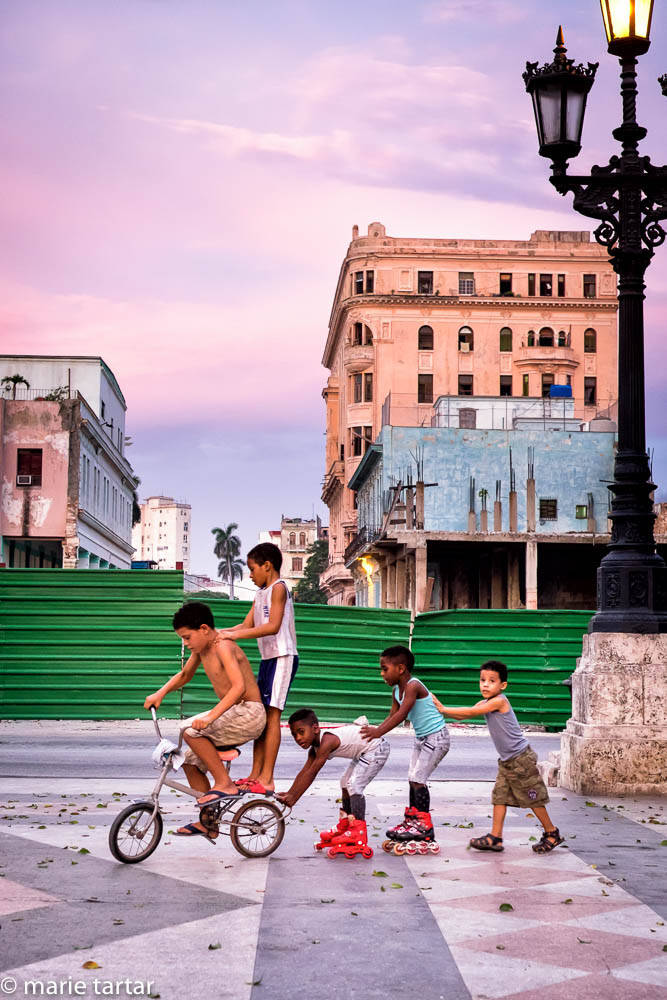
A youthful multi-wheeled train of children on the Prado, my favorite destination for photography in Havana
The Capitolio (modeled after the US Capitol building) is nearby, and leafy Parque Central is right in front of the hotel.

The best reason to stay in a hotel in Havana: the rooftop bars, with pools to cool off in and great views. Left, verdant Parque Central; undergoing restoration now, the Capitolio (modeled on the US capitol building) and in front, the neobaroque layer cake of the Gran Teatro de La Habana, home of the ballet
There is an older colonial style section, in which we were booked, and a modern section, connected below the street. Both sections have rooftop pools with bars, with great panoramic views. Like essentially all businesses in Cuba, the hotel is a joint venture between the government and a foreign concern.
Not knowing when we would arrive, I hadn’t made a dinner reservation. The concierge suggested the new grill restaurant, Al Carbon, of Iván Justo, a former chef to Fidel. I don’t know if a poster boy for Socialism is the strongest recommendation for good food or not, but hey, he was/is a head of state. It was only a few blocks away, and the ambiance was inviting. The portions were enormous. The side dishes of a grits-like version of tamale masa and salad would have been plenty. Greg’s “espada” (sword) grill option consisted of waiters coming by periodically with various grilled meats on rapier length skewers, slicing off portions. My ropa vieja (old clothes, a Cuban standard of meat stewed with tomatoes) was delicious but so filling. Sharing would have been a good option.
Wednesday, July 15, 2015
It took a little doing to figure out where our lunch destination was. In the weeks leading up to departure, many friends had provided restaurant suggestions. An unlikely source for me, but very useful, was the current issue of “Cigar Aficionado” magazine, courtesy of Harvey, who I ran into at our mutual friend James’ 4th of July party. This issue was entirely devoted to Havana, with pages of restaurant reviews. I booked Otra Manera through the Internet. Despite this, when the concierge called to decrease the number of diners from 3 to 2, they had no record of it. But, they could still take us. Yes, the concierge had a map, but it was only of Havana Vieja. And, no, they didn’t have Internet (huh?), so couldn’t show us what part of Havana the restaurant was in.
This was not an atypical experience. Cuba seems to be stuttering into the future, at least in terms of connectivity. Of 4 restaurants I contacted through their websites for reservations prior to leaving home, I received responses from 2. Of these, one had no record of our reservation, despite my printed email of their confirmation. I also engaged a photo guide prior to departure, but this was a flail as well. Our experience trying to connect is illustrative of the fits and starts of transactions in Cuba, at least for Americans subject to the ongoing embargo. I found Your Own Cuba on the web. They offered guided photography trips, so I wrote them in May seeking private photography guidance. They offered guidance for 3 people for $30 CUCs or USD/hour. I arranged for 9 hours over 3 days. They required a 1/3 deposit. I arranged to have Greg pay it, figuring we would pay the balance once there.
Paying involved very specific instructions. “Deposit of $90 CUC is by PayPal in euro (since the CUC is a closed currency only tradeable within Cuba). To finalize the booking, please make out the deposit payment of EUR 86 to….Two important things when doing the transfer:
1) You need to label the payment as payment for a service. You cannot label it a personal payment, PayPal may close an account if they think people are getting paid for services while trying to avoid paying their fees by claiming they are personal payments.
2) Do NOT write any kind of message along with the payment. PayPal being American owned if there’s anything in there that says ‘Cuba’ they could delay the transfer for weeks if not months. Our account is set up in… and we have no U.S. affiliation, so we are not under any U.S. embargo, but there is no need to encourage long delays.”
Greg paid our deposit, and I thought we were set. Four days before our departure, I wrote Tomas, telling him where we were staying and asking where we should meet. His reply was disturbing, essentially saying he had sent us instructions, we had never paid the deposit and so, no, we weren’t set. I reminded him that the payment was under Greg’s name.
When we arrived, I sent another email and received this response:
“Something went wrong along the way. I do have the deposit of course (had to double check as PayPal is blocked in Cuba).” By this time, it was already our first full day, so my original concept of a guide for 3 hours/day, from 4-7 pm, would obviously have to be reworked.
By a later email, we learned:
“Part of the confusion here is that Monday I had to leave Havana without warning to fly back to Europe as my grand dag (sic) was dying. Unfortunately he died while I was over the Atlantic. So I have pretty much been offline and with my head in other things for the last several days.
So Wednesday, as originally requested, is gone. You have 9 hours of guiding paid for which we have to divide onto Thursday and Friday then. Since I am not in Havana now, what I am going to do is send you the number to my daily rep and on the ground daily operator Manuel and pass him the the info, so you can call him up tomorrow Thursday and arrange exactly when to have those 9 hours. You will then pay the guide in cash the remaining $180 CUC upon meeting up.
So please call up Manuel first thing Thursday (but after 8 AM) on (53) (phone number)…. and coordinate how to arrange those 9 hours. Keep in mind Cubans use their cell phone much like people abroad use pagers. They don’t always pick up but go to the nearest landline phone and return the call. So if he doesn’t answer right away stay by the phone you are calling from, if he has not called back in 5-10 minutes then repeat the call.”
Well, I tried, repeatedly, on Thursday, to no avail. I first called the hotel operator to confirm exactly how many numbers I needed to dial. I received a variety of messages, most indicating the phone was offline, and never had a chance to leave a message to be called back. Of course, I wondered, why couldn’t he simply have called me at the hotel?
Frustrated, we eventually gave up. To Tomas’ credit, he did refund Greg’s deposit. In many ways, we thought it worked out fine without a guide. Transportation was easy enough to arrange ourselves, and wasn’t included with the guidance anyway.
Back to heading for lunch at Otra Manera. Naively, we started to walk in that direction.
We’d been warned it was a 15 minute cab ride. We were soon melting under the searing sun, so we bailed in Central Havana.
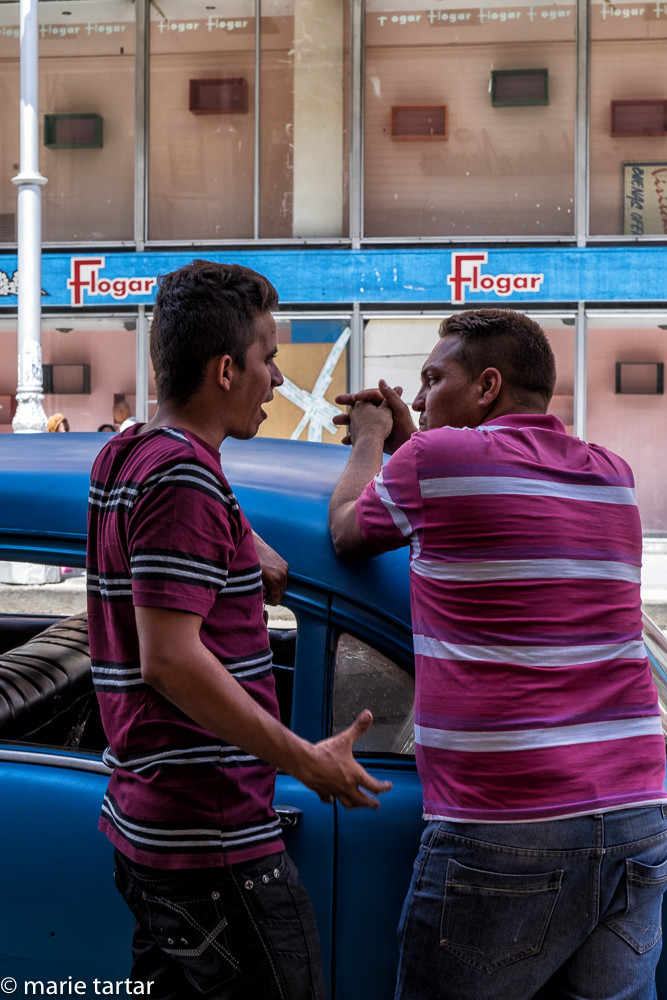
We tried to hire a pedicab, thinking it would go slow enough to be able to shoot. Learning our destination, we were ushered into a car cab (12 CUCs) for the trip to Miramar, near the Casa de la Musica Miramar.
It was worth the trip, a lovely oasis of chic, with excellent food. A standout was the sous-vide lobster and mango salad. The tuna takari was delicious, and the deconstructed lemon pie delectable.
The restaurant called a “friend” as a return cabbie for us, dropping the price for our return down to 10 CUCs/USD. This was the start of noticing considerable variability in prices for the same routes. It was not until our return to Havana after the dive trip that this observation became extremely relevant to us.
The mid-day heat was so oppressive that the rooftop pool was an irresistible magnet each afternoon. That, and the cheap (generally 3.50 CUCs/USD) and delightfully cold and refreshing omnipresent mojitos, which we found ourselves downing like water.

Determined to sample some of the more notable paladares, I had also made a reservation for dinner at a venerable institution, La Guarida, which we loved for the atmospheric setting, the artwork and the outstanding food. In the communal restroom, I recognized a print as having adorned Otra Manera’s bathroom as well, a graphic black and white rendering of a woman on a toilet. I was to see this print adorning at least one other paladares’ restroom before the trip was over.
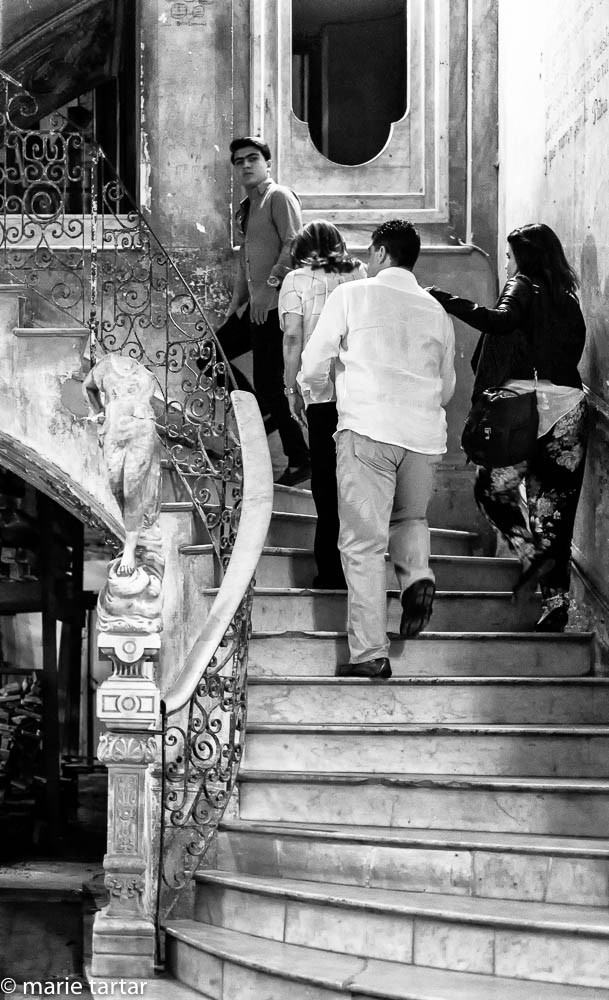
Diners head up the gritty but still magnificent marble staircase leading to famed Paladar La Guarida
La Guarida bears special mention for several reasons. It is housed in the former Camagüey mansion, which dates to 1913. The mansion subsequently housed multiple families. The chef, Enrique Núñez, was born and raised there. The profits from the restaurant have been funneled back into an ongoing restoration of the building. It was one of the early paladares, dating back to 1996. Even before that, the film “Fresa y Chocolate” (Strawberry and Chocolate) was filmed there in 1993, notable for being the only Cuban film to be nominated for an Academy Award for Best Foreign Film, as well as notable for being a Cuban film featuring an openly gay main character. The film was based on a short story by Cuban writer Senel Paz, “The Wolf, The Forest and the New Man.” The name, Paladar La Guarida, derives from the film, in which a character named Diego lived in La Guarida de Diego, or Diego’s Den. The restaurant was an “Editor’s Choice” in Cigar Aficionado, and appeared in every best Havana restaurant listing and newspaper article I read. I had completely forgotten until after the trip that a Cuban man we chatted with in line at the Tribeca Film Festival in April had given me several recommendations. Of the 3 names I looked up in my phone after returning home, I recognized one: La Guarida.
The name paladar is related to the Spanish word for palate, and refers to privately owned (as opposed to state-owned), generally small, often family owned, restaurants. Although they existed illegally in Cuba prior to the 1990s, they were legalized after the collapse of the Soviet Union and the resultant severe economic hardship of the “Special Period.”
We finished our bottle of rosé up on the rooftop deck, where the waitstaff finished up their night with a round of nightcaps.

In the dark streets of Central Havana, an alternate Cuban bar scene recalling Hopper’s iconic 1942 “Nighthawks” painting
Thursday, July 16, 2015
Having been overcome by the heat by not mobilizing early enough, Greg and I resolved to hit the streets of Havana Vieja (Old Havana) early, while the light was good and the temperature less wilting. So, we met at 6:30 am, while the dark was ebbing away.

Greg and I led a phalanx of dogs, Pied Piper style, through the streets of Old Havana during our morning photographic outings (perro blanco is pictured)
Two dogs trotted after us on heading out of the hotel, block after block, and we were later adopted by a third, a lame russet-colored female, whom Greg promptly dubbed “Santa’s Little Helper.”
Back at the hotel, we joined the throngs at breakfast, before heading up to our rooms to catch up a little on sleep. When we did mobilize, we headed to nearby Museo Nacional de Bellas Artes, including the Wilfredo Lam room, through which my sister Clarissa was dragged whimpering without being to stop on her organized tour a few years before.
We took our time on the third floor, filled with wonderful modernist early 20th century works, but hunger overcame us before we could work our way backwards in time. Nearby Sloppy Joes was a name I recognized from another of my sister’s recommendations, being one of the locales featured in Graham Green’s Our Man in Havana. Steve and I loved the film, starring Alec Guinness and Burl Ives, watching it the weekend before my departure. Greg had the namesake Sloppy Joe, spotted with green olives. My ropa vieja tacos were tasty.
After a short cooling interlude up at the rooftop pool, we took a 4 pm run in a Ford Model T convertible to Ernest Hemingway’s home turned museum, Finca La Vigía, on the outskirts of Havana, a lovely verdant property, with a giant pool.
The house was lined with books, and bristled with taxidermied trophies of the exploits of the famed big game hunter.
To round out our Hemingway experience, we had a frosty daiquiri at El Floridita, near the hotel. It is thronged with tourists, thanks to Hemingway favoring their daiquiris as “the best.” Greg and I did not undertake a scientific study of other daiquiris to test this notion, but after the sweltering streets, it did slake our thirst. I notice their sign also claims to be la cuna, the birthplace, of the daiquiri. 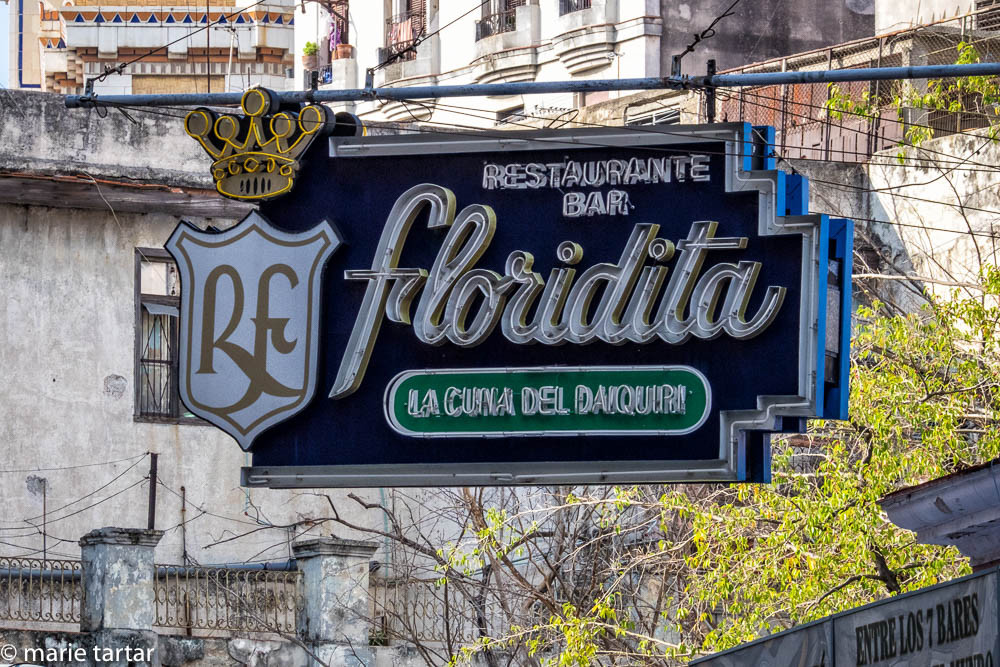
Music was being played by different bands continuously. The vocalist collecting tips after the set was thrilled with the gift of guitar strings.

Touristy or no, El Floridita serves up a refreshing daiquiri with music in an atmospheric setting. Hemingway presides over the festivities (pictured on poster, upper right, and not shown, in a life-size bronze sculpture in a corner seat at the bar to the far right)
Later, we passed the other Hemingway watering hole, La Bodeguito del Medio, on the same street as our dinner destination, El Rum Rum de La Habana. A tiny dark-skinned boy in the street did a creditable samba to the tunes emanating from the bar. After Greg gave him a box of crayons, his mother “befriended” us. She basically insisted we accompany her to another joint around the corner with “better, cheaper and larger mojitos.” She reeked of alcohol, so may well have been an expert on the local varieties of mojitos. We begged off, using our dinner reservation as an excuse.

The most photographed man in Havana? Perhaps! I met him in front of La Bodeguito del Medio, a bar famed (per Hemingway) for the “best mojitos in Havana. ” Despite our interest in researching this, we never made it inside, as it was always jam packed. The signatures of visitors adorn the walls, attesting to its popularity. “Señor Cuba” showed me his “portfolio”, including this proudly displayed turn on the cover of National Geographic Traveler
At El Rum Rum, we shared a starter of croquettes, steaming hot savory morsels of fish and potato. Their version of black seafood rice was the best of the three I was to try. The extra large mojito, heat and large quantities did me in. I started feeling light headed, and Greg helpfully pointed out we were at a high top table. I relocated to a now emptied adjacent room, with normal height chairs, closer to the ground, just in case.
The waitress came by, asking if I felt okay. My head between my knees probably signaled pretty clearly something was amiss.
“No, no me siento bien.”
She brought me a napkin soaked in cold water and the episode passed.
Friday, July 17, 2015
We had made arrangements for a car to take us around early, during the blue hour. We struck this arrangement on one of the many times we ran the gauntlet of the jineteros promoting their open air convertible taxis and tours every time we entered or left the hotel. Perhaps the early hour discouraged the driver or he stayed out too late the night before, but he wasn’t to be found in the semi-darkness. Accompanied by our adoptive white dog of the prior morning, we headed up the Prado to the Malecón, hoping to find fisherman at work.
A few were already casting off, and their numbers swelled as we hung out with them.
We were close enough to feel their lines whipping the air overhead. I was a little nervous, but Greg pointed out how close they stood to each other, aligned along the seawall.
We headed back out near noon, opting to try a CoCo, named for its rounded coconut shape, an open-air conveyance on 3 wheels, the Cuban version of the Thai tuk-tuk. In Thailand, the prospect of being in traffic in such an insubstantial vehicle, open to horrendous fumes, was out of the question. In Cuba, the streets are comparatively clear, with relatively little traffic. We lucked out with our driver, Angél, an amiable and charming young man. His former career was as a shooting athlete, through which he was able to travel to Canada, Puerto Rico and South America. He waited for us while we had another delightful lunch at Otra Manera, and then took us on a driving tour through Vedado. His route back through Miramar was through a verdant forest along the Rio Almendares, the lungs of the city. The forest was so lush and such a lovely contrast to the city that we asked to stop. Angél pointed out a small group at the river’s edge, practitioners of Santería, the Afro-Cuban religion dating back to the slave era, a synthesis of Catholicism and traditional West African religion. Slaves were not allowed to practice the Yoruba religion of their homeland and were forced to conform to their master’s practice of Catholicism, but did not regard the practices as mutually exclusive. The name derives from veneration of “Santos” or saints, also known as orishas, which are mortal manifestations of God.
The role of animal sacrifice in the practice of adherents is well explained by Justice Kennedy, from a Supreme Court decision in 1993:
The Santeria faith teaches that every individual has a destiny from God, a destiny fulfilled with the aid and energy of the orishas.The basis of the Santeria religion is the nurture of a personal relation with the orishas, and one of the principal forms of devotion is an animal sacrifice. According to Santeria teaching, the orishas are powerful but not immortal. They depend for survival on the sacrifice.
Justice Kennedy, 1993

We witnessed the sacrifice of a chicken in a riverside Santería ceremony; the blood in the foreground attests to the sacrifice of another moments before
The priest beheaded a chicken while we were watching, a much quieter, quicker and less bloody process then I envisioned.
The chicken’s body was expressed of blood into a waiting casserole dish, while he sang in a definitely not Spanish language. The blood is the offering which sustains the orisha.
Initiates (Priests or Priestesses in training) dress in all white clothing for a full year. The calm of the rushing river and the fecundity of the forest seemed like it should be a great contrast with a ritual sacrifice, but it was much less violent than I would have expected. My sister had mentioned the Santería museum, Museo de Guanabacoa de Santeria Orishas, as interesting, but we never had a chance to check it out.
After decompressing at the rooftop pool on the modern side of the hotel, using up our free cocktail vouchers on yet another round of mojitos, we headed back out with our cameras while awaiting the arrival of Steve, Cindi, Bob, and the rest of our fellow divers.

Heading up the Prado toward the Malecón again, we encountered again wonderful slices of the theatre of life on the promenade, and in the windows of the buildings lining the wide boulevard.

Young mother and child on stoop outside; so much living took place outside of apartments, I surmised they were unbearably hot

One of my favorite images from this trip; beatific father and son in an upstairs window, seen from the Prado
Greg’s crayon gifts came in handy, with beneficiaries including a darling 6 year old girl on her first day on skates, with skinned knees to show for it.
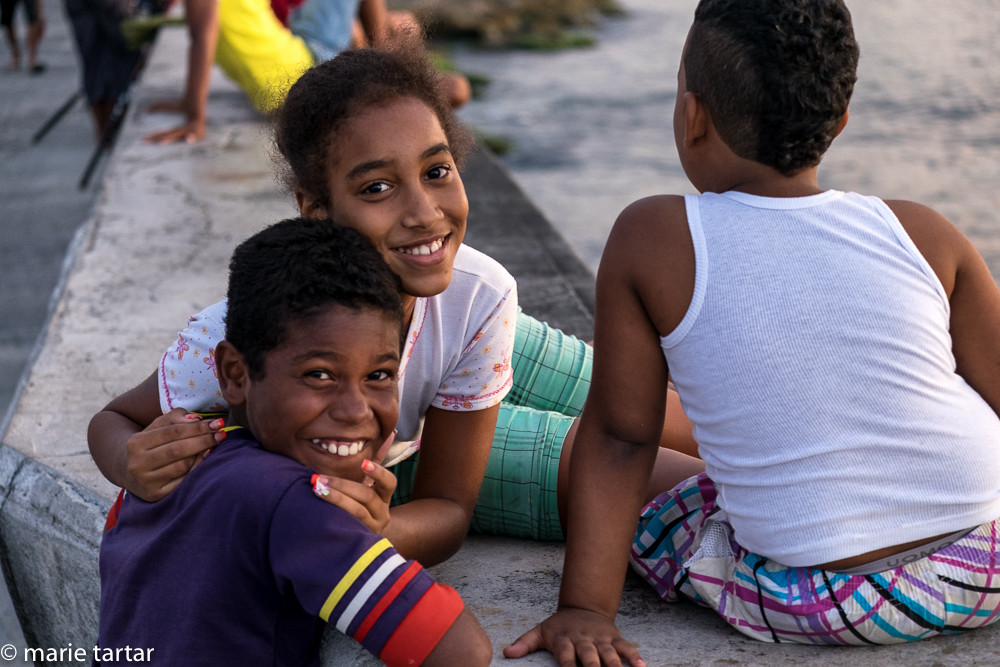
A pair of sisters posed coquettishly for their mother, taking shots of them modeling with a lion sculpture.
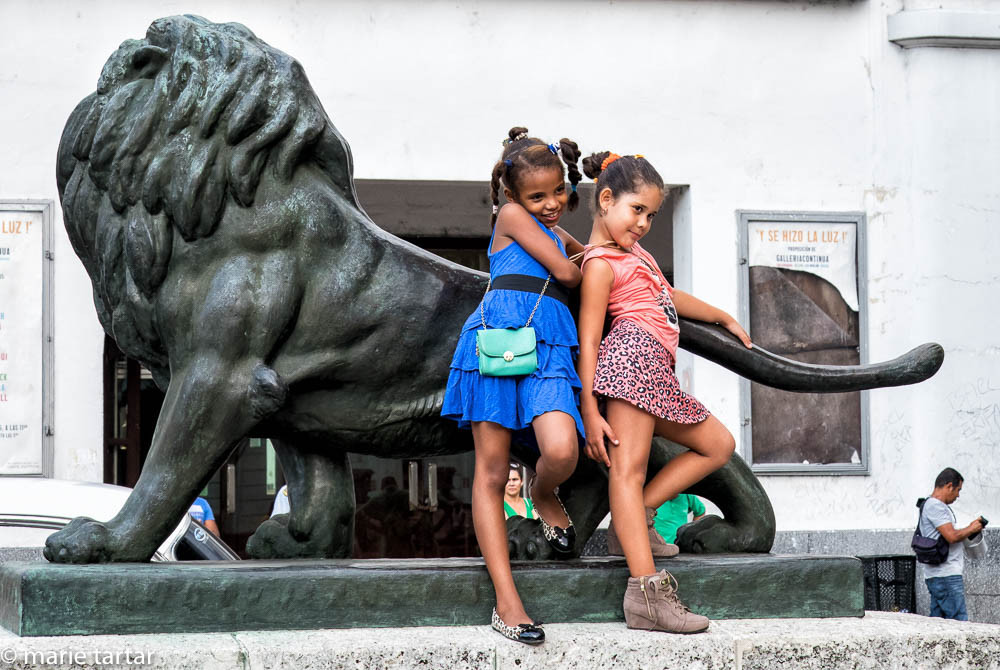
Talk about media savvy! I didn’t know whether to be amused or disturbed by these girls posing for their mother, snapping away with a cell phone camera. Let’s just say their moves were well practiced.
We enjoyed comparing impressions of Havana with Christine, an American student in Cuba for a month. At the Malecón, there were wonderful Motherwell clouds on the horizon, turning the line of lovers, musicians, and friends hanging out along the seawall into an evocative line of silhouettes. We ended the shooting session where we had begun the day, with the fishermen on the wall, casting hopefully into the distance.

Steve had arrived when we returned and the concierge arranged a late dinner for us at La Guarida. Learning we planned to walk, he appeared dubious. Having been there before, we paid him no heed. In retrospect, perhaps we should have more cautious, but Greg and I were old Havana hands now, as a sampling of the yield from our nocturnal wanderings may attest, below.
The dinner was wonderful, as before. I had a signature starter, lasagna de papaya, with thin slices of papaya instead of pasta, layered with seafood. Sadly, we had to skip nightcaps up on the rooftop bar, as our instructions were to be in the lobby at 4 am the following morning for the all day long transfer to Jardines de la Reina.
Coming soon…Part 3 of Scuba in Cuba (Jardines de la Reina)
-Marie

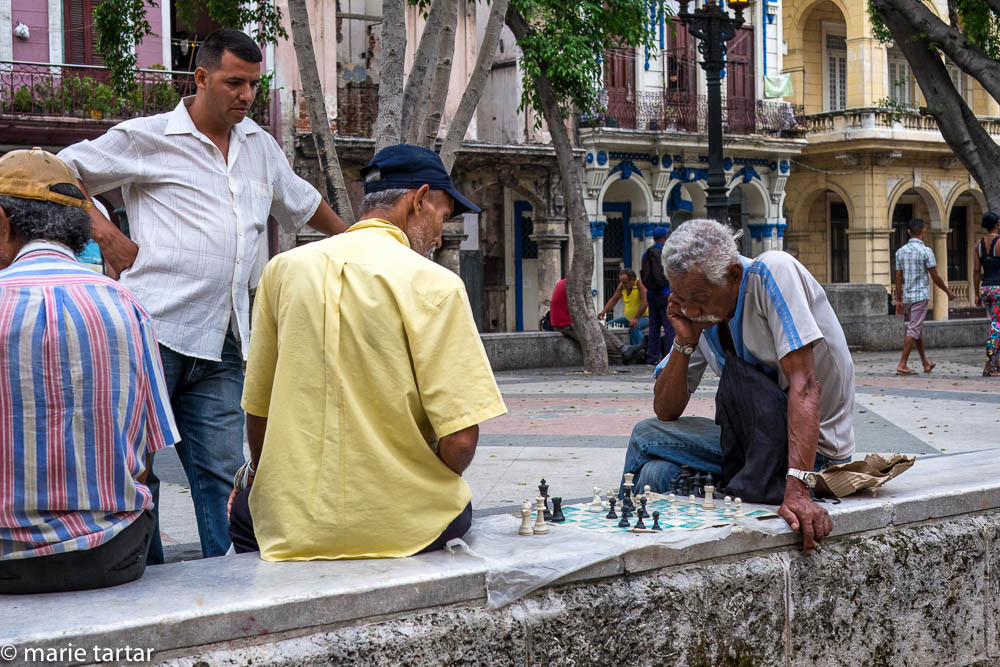
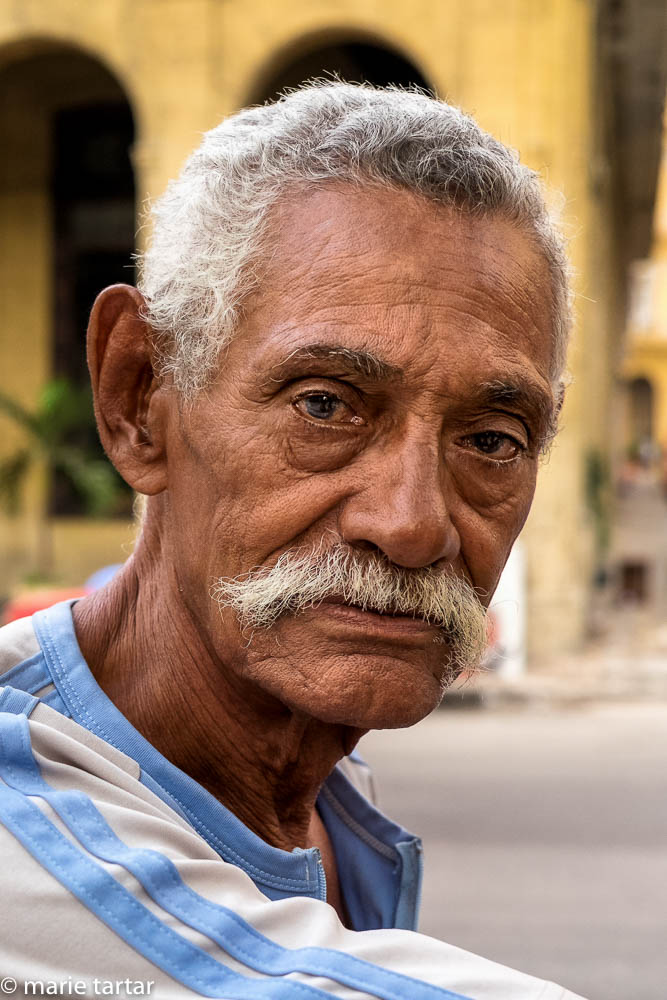


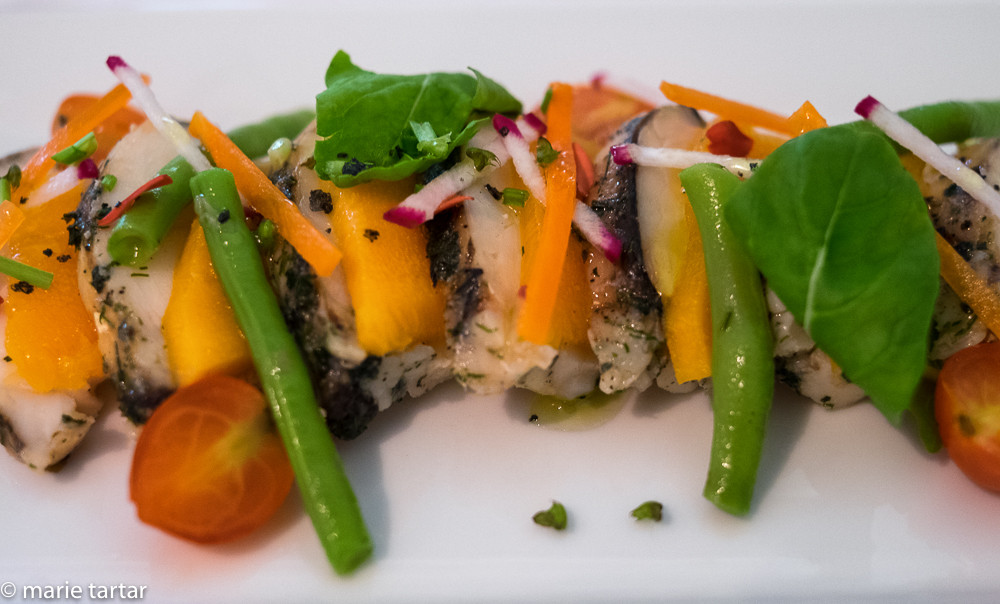
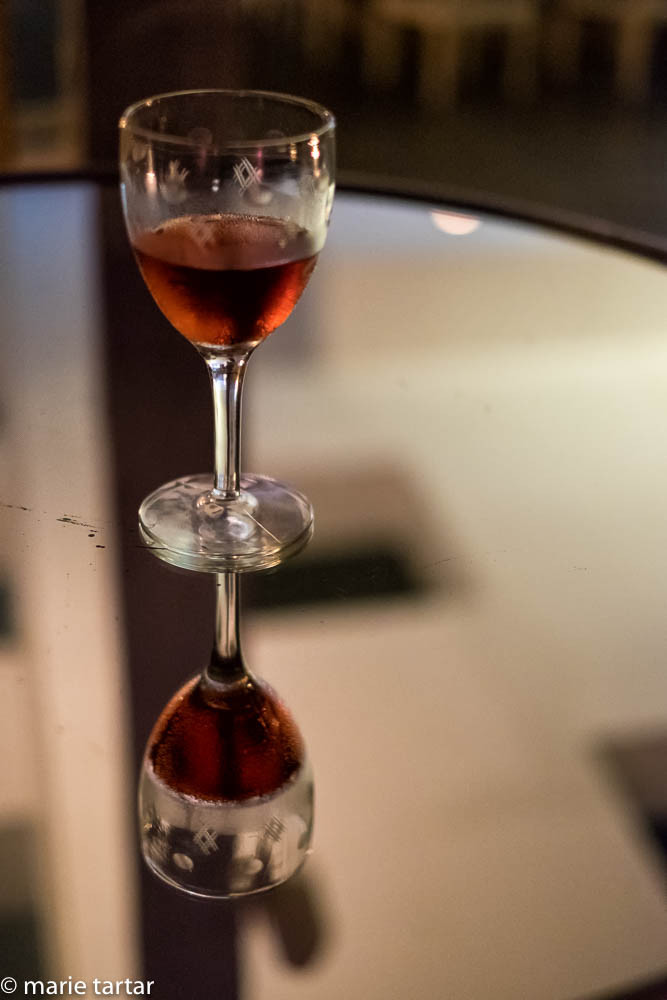
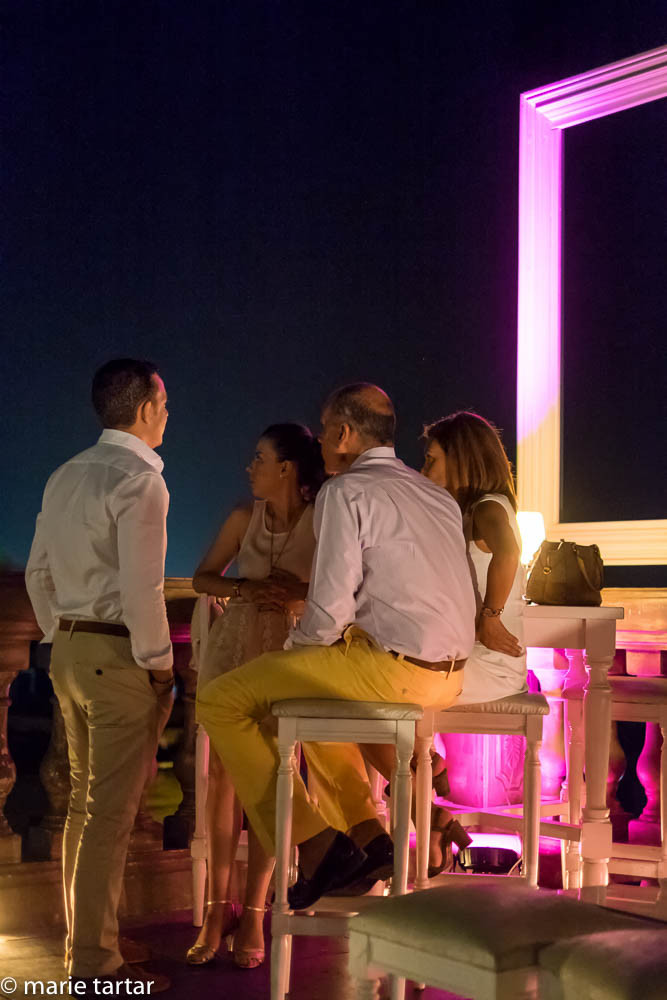

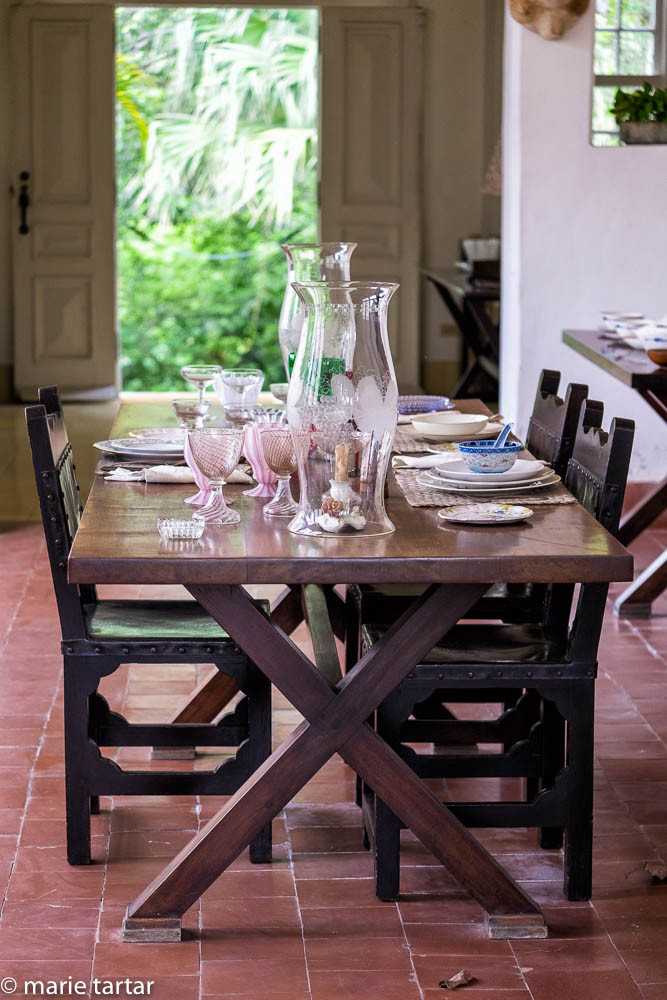
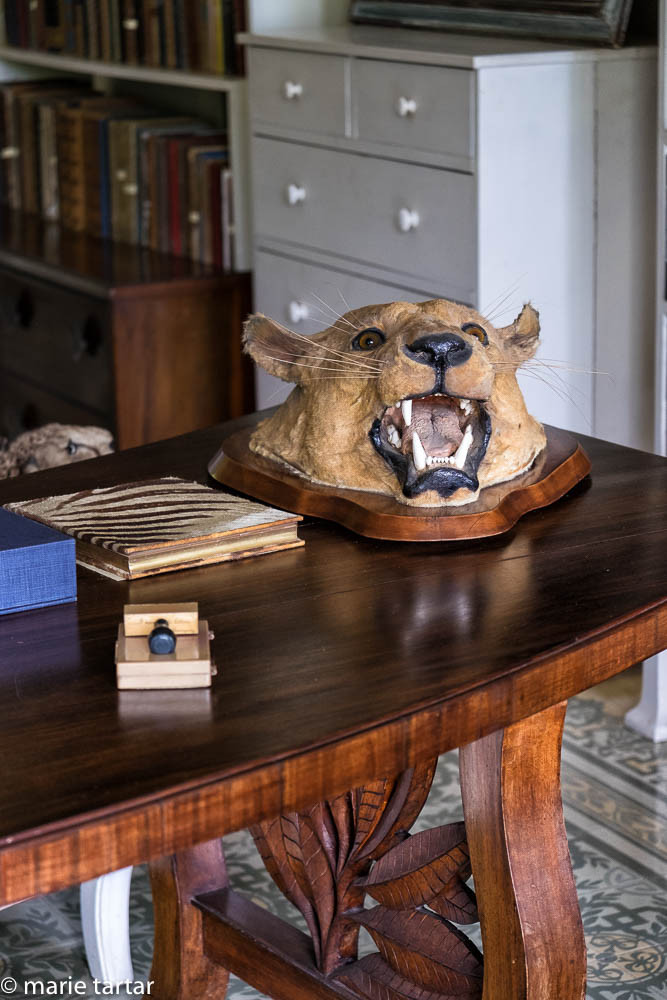

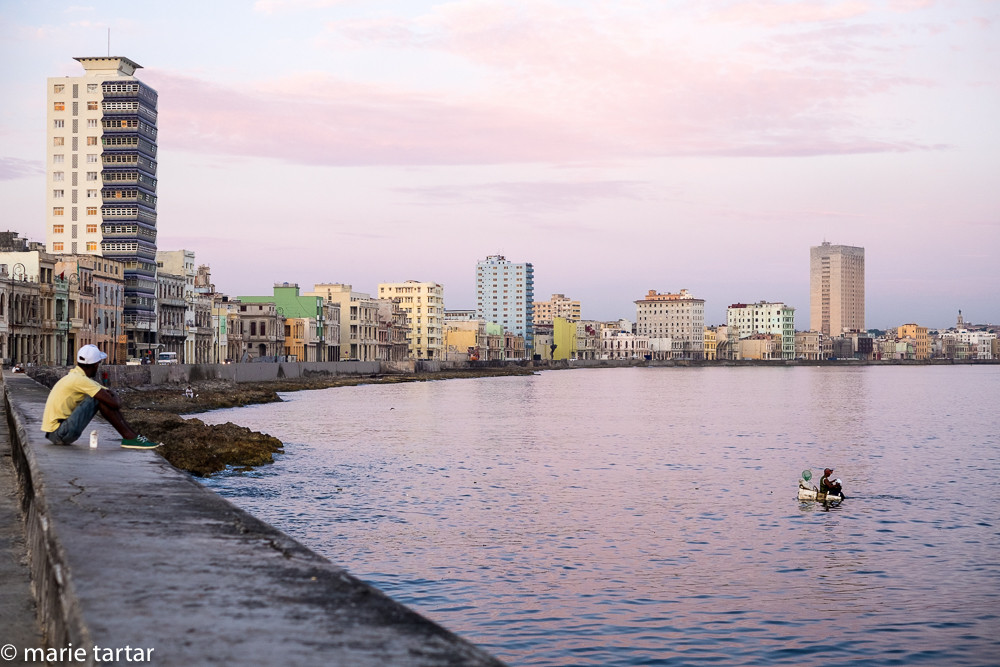
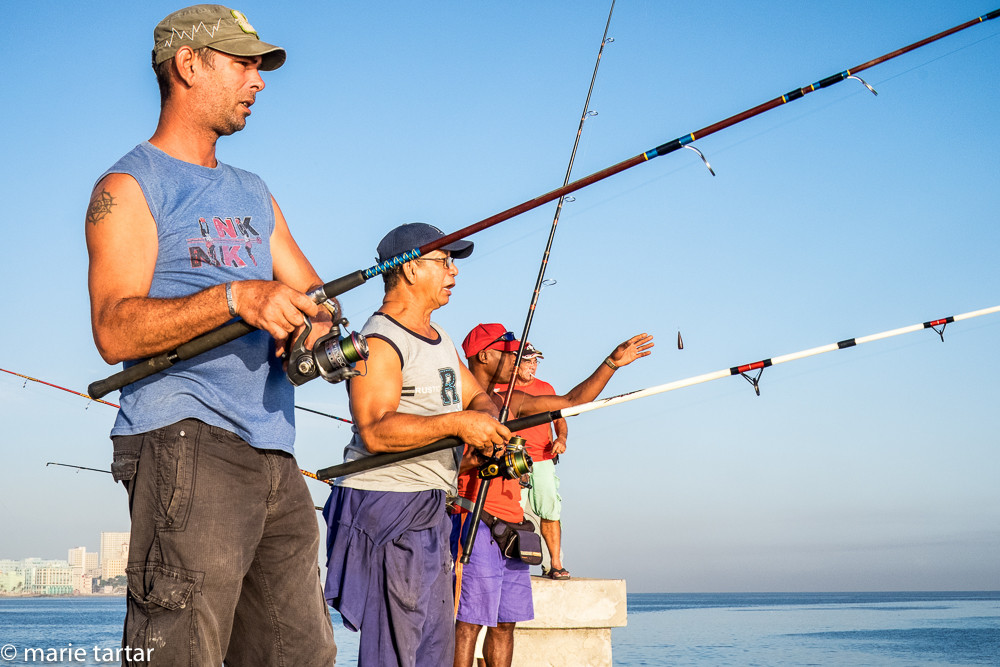



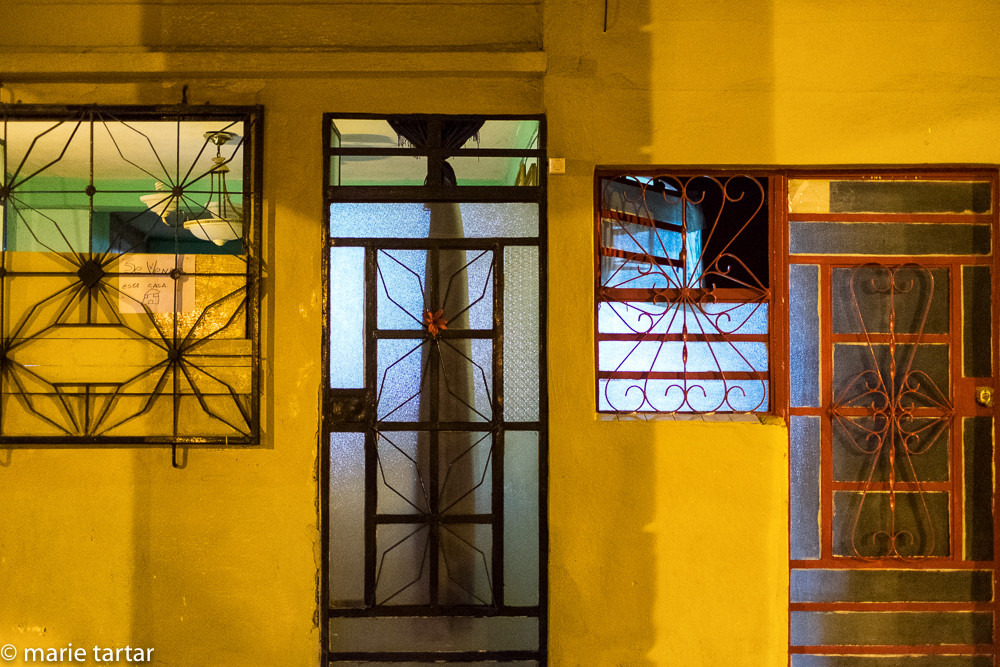

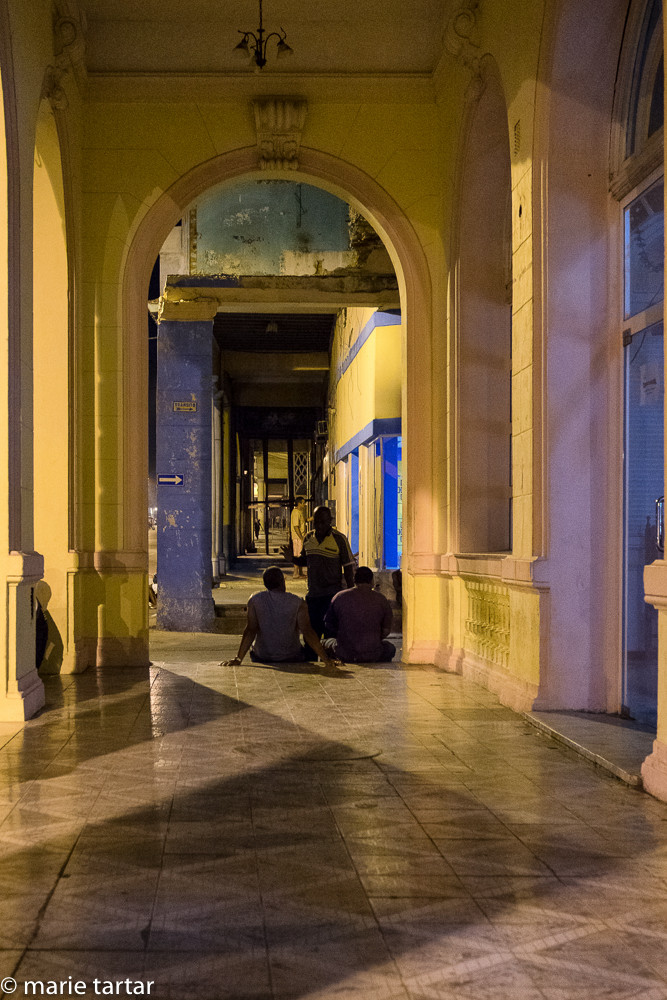
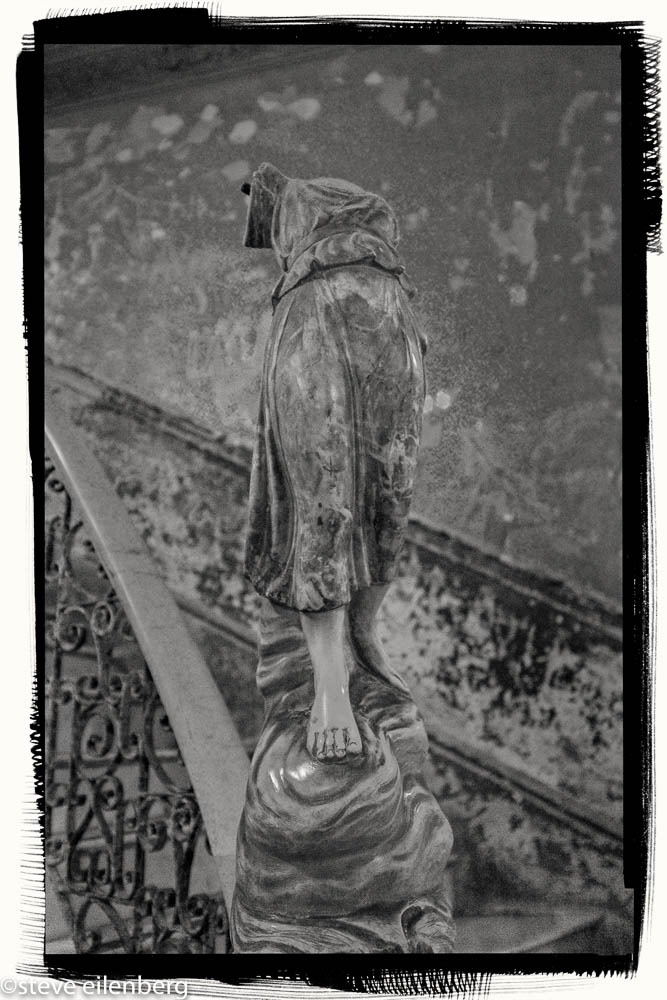
so, two questions for you. is that a taxidermy head stapler on the desk and was the chicken ok?
You’re probably right! And to think I thought the head purely decorative! As for the chicken, well…I learned from Greg that chickens turned upside down go into a meditative state. We observed this technique employed first hand.
Ahhh… Another fine virtual trip. The colors, light and subject matter of photos take me there and the words add texture. Just listened to this documentary on Cuba by BBC
http://bbc.in/1Ept3Po
Thanks, Patricia, for this link! I look forward to checking it out!
-Marie
Beautiful evocative photographs Marie. What an unforgettable trip!
Thanks, Bob! Unforgettable, in a word, in every way!!
-Marie
Amazing trip report! I can’t wait for part Part 3…
Querida Marie, Thanks for sharing your wonderful images and impressions of Cuba. having been there back in 1989 & ’90, I am glad to see that the poetically (or tragically) crumbling infrastructure and beautiful resilient people remain very much as I remember… saludos
muchissimas gracias, Hector! so many people are saying (as did we) that that want to see Cuba before it is “ruined.” my impression now is that they have plenty of time. it takes a lot of effort and time to undo so many years of neglect.
Lovely images and story line, as always, Marie. Bravo!
thanks, Steve, i really found Cuba visually stimulating!
wonderful narrative and photos.. subtitles to the movie playing in my head while i read and enjoy your photos. Thanks for taking me along on your adventure. s
and thanks for being such a willing companion, Steph!
Fabulous photos, Marie, and such a vivid telling!
Thanks, Susan! It was a colorful place!
-Marie
!Que bravas! A few questions: Did you happen to see Hemingway’s curated sport fishing boat “Pilar” at the compound? Did you meet with the curator in residence? If she is who I am thinking of, at least at one time in the past, she was an American expatriate. I am curious about the lives of the long-term American expatriates who reside in Havana and elsewhere in Cuba [other than at the GITMO concentration camp]. Did you meet any?
Yes, Pilar is at the Hemingway compound. We went in the final hour for better light, so no curator was in evidence. No, we spoke to many Cubans but not any American ex-pats.